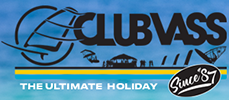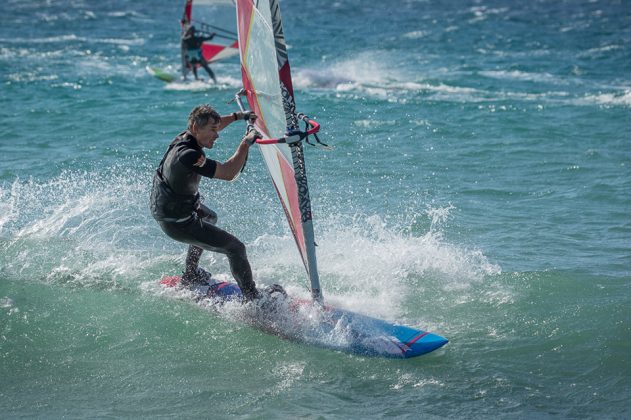What level of impairment does it take to stop us challenging the upper levels of windsurfing? Two new hips? Apparently not.
Words Peter Hart
Originally published within the November ’17 edition.
I came round in the recovery room staring at the ceiling feeling strangely euphoric – that’s morphine for you. It was a happy bubble that was soon to be pricked by the fine-boned doctor standing over me, who had just done the operation.
“So doc,” I said grinning inanely, “how’s it looking?”
“Mr Hart,” he replied with the look of a Victorian headmaster, “you have the knee of a seventy year old,” (I was 31 at the time).
“Well I better give it back then,” I said before creasing up in drug-induced hysterics.
From his stony expression, he’d evidently heard that one before and then delivered the killer line. “You really need to rethink what you do with your life – professional sport is over for you.” He explained that I had irreparable damage to the joint surface that would get ever worse the more I jumped up and down on it. Not even the finest quality morphine could soften that blow.
But then shortly after, in walked Magnus. Magnus was the senior surgeon with whom I had my initial consultation; and as a former rugby-player, was an altogether different animal.
“What’s the matter old boy? Don’t tell me … old misery-guts has been to see you … bloody good young surgeon, does a better job at that fiddly stuff than me, but he’s never done a day’s sport in his life. Doesn’t get it. Thinks anyone who plays silly games is an unnecessary burden on the NHS.”
“So will I really have to give up windsurfing?”
“Bloody hell no! We’ll keep you going with a trim here and tuck there. Just keep it strong and probably best to give up squash and marathon running.”
“So when will I have to?” I asked slightly more optimistically.
“Oh not for a while – but you’ll know when – too bloody painful!” And so saying let out a Lord Melchett style ‘baaaah!” before leaving the room to cheer up someone else.
Three weeks later I was in Fuerte’ for the PWA slalom and 25 years on I appear to be still going. Both docs were sort of right. The knee has got steadily worse, but it may actually have made me a better windsurfer, as I now concentrate on finding easier more efficient ways to do things. But I have yet to have major surgery. So what are the limits?
Page Boy
I know a host of Windies of middle age and well beyond who can’t entertain the prospect of having to give up the sport and wonder what level of decrepitude it would take to prevent them attacking the upper levels.
Well they will surely take inspiration from 60-year-old Andy Page who windsurfs with two artificial hips. And we’re not talking pootling about on a pond. When he’s not desiccating the waves, he’s rolling out a plethora of tricks in all weathers. Known as ‘Tigger’ by his close friends due to his incessant bouncing and disproportionate optimism, he continues to windsurf with insane enthusiasm. The opinion of those in the medical profession is surely that Andy is a very naughty boy who is ignoring doctor’s advice and will live to regret his foolhardiness. But here’s the thing – Andy IS a doc, a consultant interventional radiologist, who therefore approaches his condition with knowledge and a bunch of useful contacts. Living on both sides of the scalpel, he’s uniquely placed to offer advice to similarly crocked windies.
Stood up too soon
In short, Andy had a genetic quirk where his hip joints were twisted slightly forward. “I had hips dating back a few million years – I was designed to be on all fours. I basically stood up too soon.” This led to premature osteoarthritis in the joints, which resulted in restricted movement and a lot of pain.
“At the age of 45 I was basically a cripple. I couldn’t run. I could only walk short distances and needed a stick. About the only thing I could do was windsurf.”
I met Andy in this era when I was asked to coach a group of windsurfing doctors at their annual conference in Tarifa. On the water, his energy was boundless but his technique unorthodox. He tacked and gybed like a frenetic rabbit, hopping his feet to the new side; and when he carved his knees would point in diametrically opposed directions, a bit like an old dear squatting down.
“The degraded cartilage led to impingement. I couldn’t internally rotate my hip hence the jumping and the strange knee position – it also meant I couldn’t snowplough when skiing.”
Just recently he’s had his second hip replaced and is sailing better than ever.
“The irony is that I have more freedom of movement at the age of 60 than I did at 35 so I’m enjoying a real second wind.”
Of course every case has to be assessed individually, but Andy has sound general advice for anyone facing this sort of procedure.
Fit
“When you get joint problems it’s frightening how quickly muscles waste. You lose your quads, your knees become unstable (hence often people with bad hips present with sore knees) and you get back pain because the sacroiliac joint tries to compensate for lack of movement. So faced with joint replacement, see a physio and get as fit and strong as possible before the op. When you have joint problems, it’s all too easy to get chronically unfit.”
Rehab
“It’s like a war wound. Following the op, you have severely damaged tissue. Despite your eagerness, do what they tell you! Which will be to do nothing for the first 6-9 weeks. That’s the time needed to let everything harden up and hold the hip in place. For the same reason you mustn’t stretch too early or you’ll weaken the tissues. I treated the rehab as a professional athlete. At 6 weeks I returned to the gym. I didn’t want to use my hip – I obeyed orders on that front – but I wanted to work my upper body and everything else as hard as I could. With a hard cardiovascular workout, you’re driving blood through the injured component. Blood cleanses and takes out damaged tissue and delivers protein sugar fat needed to rebuild it.”
And on the water, is there anything he avoids?
“Dislocation is the greatest danger on the water. You’d be in severe pain; the limb would go into spasm and could drag you down. A car crash is the best way to dislocate a hip. The hips are flexed and the hip is driven out the back – and that’s kind of what happens on a flat landing. So I avoid them, and if I suspect I’m heading for one, I bail … which is what I’d do anyway.
I think the general rule is that it’s fine to do what you did before because you’re familiar with the movements. It’s the unexpected that’s the worry, so I avoid new school freestyle with its twisted, violent endings. General old school carving and wave riding is fine because the pressure comes on gradually. Slalom/free-riding is good too.”
And has it been worth it?
“Absolutely! But you have to really want it and it’s bloody hard work!” And so saying, he set about preparing for the Masters section of the Tiree Wave classic.
PH 4th October 2017.
Andy Page, newly jointed, ripping in Tarifa.
Photo Barbara Close.


